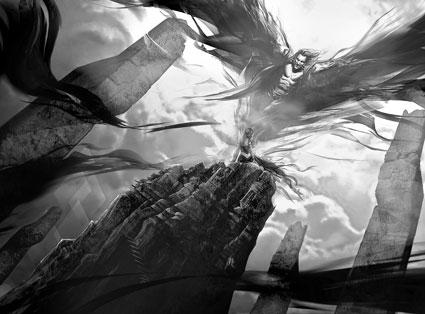Over the last few months I’ve had the pleasure of working with the curators of Heroes and Villains: The Battle for Good in India’s Comics and two of the artists featured in the exhibition, Mukesh Sing and Jeevan J. Kang, in commissioning limited-edition prints inspired by the show.

Jeevan J. Kang, “Ravan abducts Sita,” scene from Ramayan 3392 AD (2006)
Having been steeped in this contemporary component of the exhibition, I was excited to see the Indian paintings that make up the other half of the show, now that the exhibition is open. With the help of co-curator Tushara Bindu Gude, I learned more about these works, each depicting a fascinating world with animal and human fiefdoms vying for power.
My favorite work in the show is a nineteenth-century painting that recounts part of the ancient story of Ramayana, aka Adventures of Rama. Sugriva, king of the monkeys, makes a deal with Rama to help him free Sita (Rama’s wife) from captivity. But Sugriva has one condition—Rama must help him overthrow Sugriva’s older brother from whom Sugriva stole the throne. The painting shows us Sugriva ensconced on his opulent throne within a cave and surrounded by members of his court. His loyal general, Hanuman, is shown rushing out of the cave to galvanize an army of monkeys and join Rama in his quest to free Sita and defeat her captor Ravana. It’s an exquisitely rendered work with saturated colors and incredible details.

India, Himachal Pradesh, "Kangra Sugriva Sends Emissaries, Led by Hanuman, to Find Princess Sita," c. 1830–1840, Southern Asian Art Council
In the next gallery, a modern version of Hanuman is imagined by a Liquid Comics artist, Abishek Singh, in a serene moment perched on a tree branch and playing a flute.

Abishek Singh, "Character exploration for Hanuman," Ramayan 3392 AD, 2006, Liquid Comics, Bangalore, India, © Liquid Comics, all rights reserved
In the gallery featuring the Indian paintings there is also a series of works which might be considered part of the early evolution of the graphic novel. These are bold watercolors illustrating a tale derived from the Indian epic Mahabharata and were used to illustrate the story when it was told aloud. They show everything from fierce battles to miracles in the story of Babhruvahana, a tale of war and complicated family dynamics. Babhruvahana is forced to kill his father in a battle over territory and is then promptly told by his mother to bring him back to life. Babhruvahana recruits a mongoose army and fights a legion of snakes to obtain the elixir that will bring his father back from the dead. (Some of these watercolors were previously discussed on Unframed here.)

India, Maharashtra, Paithan "Fight of the Mongoose and the Serpent Armies (recto), Babhruvahana and the Mongoose Fight the Serpents (verso), Scenes from the Story of Babhruvahana, Folio from a Mahabharata (War of the Great Bharatas)," c. 1850, from the Nasli and Alice Heeramaneck Collection, Museum Associates Purchase
Today, Liquid Comics has brought new life to the amazing myths and stories of ancient India. More info can be found here should you want to bring a little bit of the mythical into your own home.
Erin Wright, Director of Special Projects



